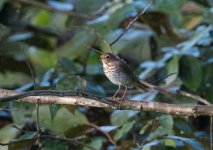Nightjar61
David Daniels

Do both occur in Costa Rica, descriptions of the range of each species suggest that they do so like many people, I will now have to try and resolve the ID of birds I saw there?
According to Cornell Lab of Ornithology’s “All About Birds” website, “Russet-backed Thrush” winters in Central America and Swainson’s Thrush winters in South America. I would assume that Swainson’s Thrushes migrate through Central America on their way to South America.
Dave









